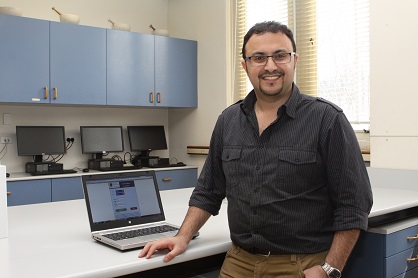 School of Pharmacy lecturer Hesham Al-Sallami isn't planning to become an app developer any time soon.
School of Pharmacy lecturer Hesham Al-Sallami isn't planning to become an app developer any time soon.
Hesham Al-Sallami, lecturer and pharmacometrics afficionado, at work at the School of Pharmacy. Photo courtesy of Lisa Reid.
But, with a lot of help and late-night labouring away at the computer, Dr Al-Sallami learned enough code to turn his latest pharmacometric innovation into an online tool.
Work on drug dosing for children in Dunedin Hospital led Dr Al-Sallami to research fat-free mass as a determinant of drug metabolism.
Calculating a dose based on weight, without knowing how much is lean and how much is fat, risks giving a bigger dose than the body can handle, he says.
With colleagues, national and international collaborators and graduate students, he collected and tested data to inform drug decision-making in paediatrics.
The end result is the Fat Free Mass Calculator, a web-based app found live at http://pharmacometrics.co.nz/linked/fatfreemass.php
The calculator can be applied to a small but expanding array of medications.
As far as Dr Al-Sallami knows, only two New Zealand clinicians are using it. But he is keen for more to pick it up. Though it has potential as an app for mobile devices, that would be a commercial project and not one he himself would want to take on.
The calculator is one of many of Dr Al-Sallami's recent projects that reinforce the value of pharmacists' knowledge of pharmacokinetics and pharmacodynamics.
He says the calculator was a highlight of his PhD thesis, entitled Optimising patient care by individualising drug dosage. The doctorate was awarded in August.
The research reinforced the fact that the role of guidelines is, quite simply, to guide – not to overrule professional judgement based on detailed understanding of the individual patient.
An Otago BPharm graduate who was born in Yemen but has lived in Dunedin for the past 20 years, Dr Al-Sallami has also developed a teaching tool that predicts how warfarin will behave depending on dose, duration, body weight and presence of specific genotypes.
As part of his thesis studies, he modelled the dose-response relationship of enoxaparin, a drug that is increasingly used in children for the treatment of thrombosis.
Earlier, he had worked on measuring anti-Xa plasma concentration during treatment with enoxaparin (Pharmacy Today, September 2009). The data tended toward proving his hypothesis – that routine monitoring is needed when treating patients with this drug. Unfortunately, the study was under-powered but it was instructive to have the experience designing and running a clinical trial.
Since then Dr Al-Sallami has found conferences a great way to meet experts from other countries and, often, to agree collaborations and access to data.
He says he has had fantastic support, supervision and expertise from the School of Pharmacy, Dunedin Medical School and other University of Otago departments. He also likes to keep in touch with the shop floor by working a couple of times a month in a community pharmacy.
Dr Al-Sallami has been lead author or co-author of numerous published articles, including one in the New Zealand Medical Journal on the need for dose indiviualisation with dabigatran.
His love for his work is evident when he says: “Everything we do is trying to quantify, and then apply, dose response.”
Article written by Virginia McMillan, for Pharmacy Today, November 2015
